2,4(1H,3H)-Pyridinedione,3,3-diethyl-
Modify Date: 2025-08-25 12:15:17
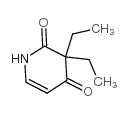
2,4(1H,3H)-Pyridinedione,3,3-diethyl- structure
|
Common Name | 2,4(1H,3H)-Pyridinedione,3,3-diethyl- | ||
|---|---|---|---|---|
| CAS Number | 77-04-3 | Molecular Weight | 167.20500 | |
| Density | 1.029g/cm3 | Boiling Point | 187-189ºC (14 mmHg) | |
| Molecular Formula | C9H13NO2 | Melting Point | N/A | |
| MSDS | N/A | Flash Point | 147.8ºC | |
| Name | 3,3-diethyl-1H-pyridine-2,4-dione |
|---|---|
| Synonym | More Synonyms |
| Density | 1.029g/cm3 |
|---|---|
| Boiling Point | 187-189ºC (14 mmHg) |
| Molecular Formula | C9H13NO2 |
| Molecular Weight | 167.20500 |
| Flash Point | 147.8ºC |
| Exact Mass | 167.09500 |
| PSA | 46.17000 |
| LogP | 1.33420 |
| Index of Refraction | 1.464 |
| InChIKey | NZASCBIBXNPDMH-UHFFFAOYSA-N |
| SMILES | CCC1(CC)C(=O)C=CNC1=O |
Synonym:Didropyridine; 3,3-Diethyl-2,4-pyridinedione; 3,3-Diethyl-2,4-(1H,3H)-pyridinedione; Dihydroprylone; Pyridione; Pyrithyldion Section 2 - COMPOSITION, INFORMATION ON INGREDIENTS
Risk Phrases: 20/21 Section 3 - HAZARDS IDENTIFICATION EMERGENCY OVERVIEW
Harmful by inhalation and in contact with skin.Harmful. Potential Health Effects Eye: May cause eye irritation. Skin: May cause skin irritation. The toxicological properties of this material have not been fully investigated. Ingestion: The toxicological properties of this substance have not been fully investigated. May be harmful if swallowed. May cause central nervous system depression. Inhalation: The toxicological properties of this substance have not been fully investigated. May cause irritation of the mucous membranes. Chronic: Not available. Section 4 - FIRST AID MEASURES Eyes: Flush eyes with plenty of water for at least 15 minutes, occasionally lifting the upper and lower eyelids. Get medical aid immediately. Skin: Get medical aid. Flush skin with plenty of soap and water. Ingestion: Never give anything by mouth to an unconscious person. Get medical aid immediately. Do NOT induce vomiting. If conscious and alert, rinse mouth and drink 2-4 cupfuls of milk or water. Inhalation: Remove from exposure and move to fresh air immediately. If not breathing, give artificial respiration. If breathing is difficult, give oxygen. Get medical aid. Notes to Physician: Section 5 - FIRE FIGHTING MEASURES General Information: As in any fire, wear a self-contained breathing apparatus in pressure-demand, MSHA/NIOSH (approved or equivalent), and full protective gear. During a fire, irritating and highly toxic gases may be generated by thermal decomposition or combustion. Extinguishing Media: Use water spray, dry chemical, carbon dioxide, or appropriate foam. Section 6 - ACCIDENTAL RELEASE MEASURES General Information: Use proper personal protective equipment as indicated in Section 8. Spills/Leaks: Sweep up, then place into a suitable container for disposal. Avoid generating dusty conditions. Provide ventilation. Section 7 - HANDLING and STORAGE Handling: Wash thoroughly after handling. Remove contaminated clothing and wash before reuse. Use with adequate ventilation. Avoid contact with eyes, skin, and clothing. Avoid ingestion and inhalation. Storage: Keep containers tightly closed. Store in a cool, dry area away from incompatible substances. Section 8 - EXPOSURE CONTROLS, PERSONAL PROTECTION Engineering Controls: Facilities storing or utilizing this material should be equipped with an eyewash facility and a safety shower. Use adequate ventilation to keep airborne concentrations low. Exposure Limits CAS# 77-04-3: Personal Protective Equipment Eyes: Wear appropriate protective eyeglasses or chemical safety goggles as described by OSHA's eye and face protection regulations in 29 CFR 1910.133 or European Standard EN166. Skin: Wear appropriate protective gloves to prevent skin exposure. Clothing: Wear appropriate protective clothing to prevent skin exposure. Respirators: A respiratory protection program that meets OSHA's 29 CFR 1910.134 and ANSI Z88.2 requirements or European Standard EN 149 must be followed whenever workplace conditions warrant respirator use. Section 9 - PHYSICAL AND CHEMICAL PROPERTIES Physical State: Powder Color: white Odor: none reported pH: Acidic in aq soln. Vapor Pressure: Not available. Viscosity: Not available. Boiling Point: 187.0 - 189.0 deg C @ 14.00mm Freezing/Melting Point: 81-86 deg C, 92-93 deg C, Autoignition Temperature: Not applicable. Flash Point: Not applicable. Explosion Limits, lower: Not available. Explosion Limits, upper: Not available. Decomposition Temperature: Not available. Solubility in water: Moderately Soluble. Specific Gravity/Density: Not available. Molecular Formula: C9H13NO2 Molecular Weight: 167.21 Section 10 - STABILITY AND REACTIVITY Chemical Stability: Stable under normal temperatures and pressures. Conditions to Avoid: Incompatible materials, strong oxidants. Incompatibilities with Other Materials: Strong oxidizing agents. Hazardous Decomposition Products: Nitrogen oxides, carbon monoxide, carbon dioxide. Hazardous Polymerization: Has not been reported Section 11 - TOXICOLOGICAL INFORMATION RTECS#: CAS# 77-04-3: UT2810530 LD50/LC50: CAS# 77-04-3: Oral, rat: LD50 = 780 mg/kg. Carcinogenicity: Pyrithyldione - Not listed by ACGIH, IARC, or NTP. Other: See actual entry in RTECS for complete information. Section 12 - ECOLOGICAL INFORMATION Other No information available. Section 13 - DISPOSAL CONSIDERATIONS Dispose of in a manner consistent with federal, state, and local regulations. Section 14 - TRANSPORT INFORMATION IATA Shipping Name: TOXIC SOLID, ORGANIC, N.O.S.* Hazard Class: 6.1 UN Number: 2811 Packing Group: III IMO Shipping Name: TOXIC SOLID, ORGANIC, N.O.S. Hazard Class: 6.1 UN Number: 2811 Packing Group: III RID/ADR Shipping Name: TOXIC SOLID, ORGANIC, N.O.S. Hazard Class: 6.1 UN Number: 2811 Packing group: III Section 15 - REGULATORY INFORMATION European/International Regulations European Labeling in Accordance with EC Directives Hazard Symbols: XN Risk Phrases: R 20/21 Harmful by inhalation and in contact with skin. Safety Phrases: S 23 Do not inhale gas/fumes/vapour/spray. WGK (Water Danger/Protection) CAS# 77-04-3: No information available. Canada None of the chemicals in this product are listed on the DSL/NDSL list. CAS# 77-04-3 is not listed on Canada's Ingredient Disclosure List. US FEDERAL TSCA CAS# 77-04-3 is not listed on the TSCA inventory. It is for research and development use only. SECTION 16 - ADDITIONAL INFORMATION N/A |
CHEMICAL IDENTIFICATION
HEALTH HAZARD DATAACUTE TOXICITY DATA
|
|
~% 
2,4(1H,3H)-Pyri... CAS#:77-04-3 |
| Literature: Hoffmann-La Roche Patent: US2090068 , 1936 ; Full Text Show Details Tsukita Yakugaku Zasshi, 1949 , vol. 69, p. 194 Chem.Abstr., 1950 , p. 1507 Show Details Hoffmann-La Roche Patent: DE634284 , 1935 ; Fortschr. Teerfarbenfabr. Verw. Industriezweige, vol. 23, p. 459 |
|
~% 
2,4(1H,3H)-Pyri... CAS#:77-04-3 |
| Literature: Tsukita Yakugaku Zasshi, 1949 , vol. 69, p. 194 Chem.Abstr., 1950 , p. 1507 |
| Pyrithyldion |
| Presidon |
| Pyridion |
| Persedon |
| EINECS 201-000-5 |
| Didropyridine |
| 3,3-Diaethyl-1H-pyridin-2,4-dion |
| Persidon |
| 3,3-Diethyl-2,4-dioxo-1,2,3,4-tetrahydro-pyridin |
| Dihydroprylone |
| Benedorm |
| Prezidon |
| pyrithyldione |
| Didropyridin |
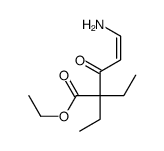

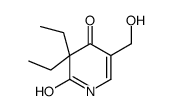 CAS#:20096-03-1
CAS#:20096-03-1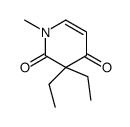 CAS#:1130-18-3
CAS#:1130-18-3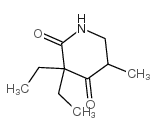 CAS#:125-64-4
CAS#:125-64-4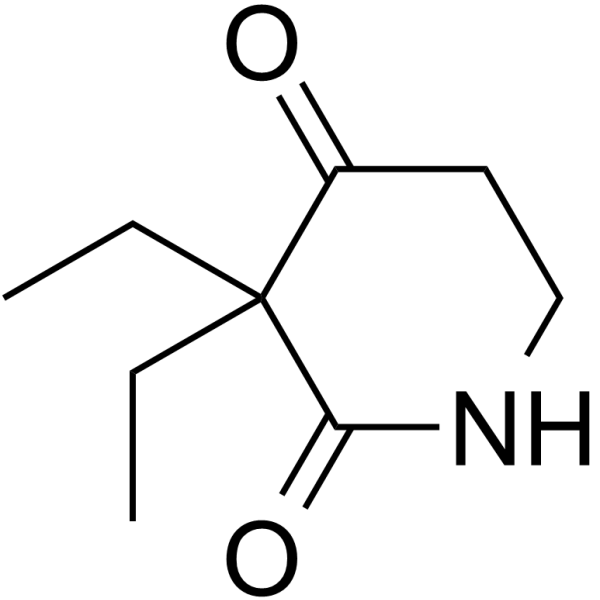 CAS#:77-03-2
CAS#:77-03-2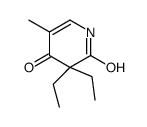 CAS#:467-90-3
CAS#:467-90-3